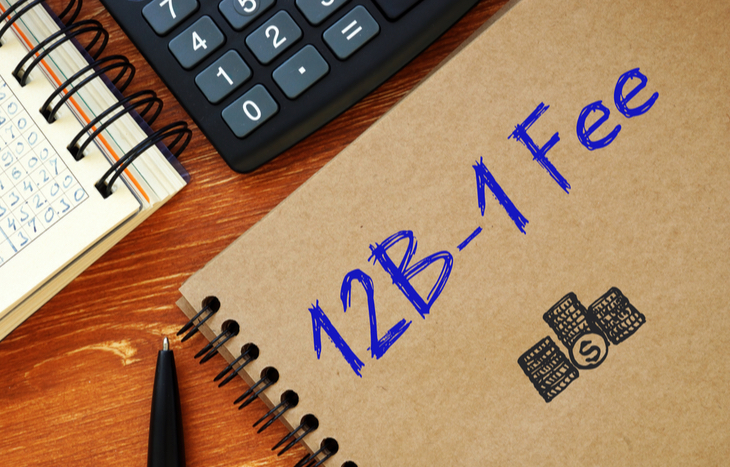What Is a 12b-1 Fee?
Fees are something every investor needs to be aware of. If you’re looking at investing in a mutual fund, for example, you might see a specific type of fee attached: a 12b-1. What is a 12b-1 fee, and what are you paying for when you choose to invest in a fund that has one?
The answer comes from an SEC rule of the same name, which allows managed funds to charge a fee for marketing, distribution and administration expenses. This fee typically ranges from 0.25% and 0.75% and is incorporated in the fund’s expense ratio. It’s not always evident in a cursory evaluation of the fund, which is why it pays for investors to probe deeper.
Here’s what you need to know about 12b-1 fees, why they’re charged and what their purpose is in modern-day managed funds.

A Brief History of 12b-1
The 12b-1 fee was actually designed to benefit investors. Money collected through the fee originally funded marketing expenses for the fund. The better-marketed the fund, the more assets under management and the higher the returns. It was a worthwhile expense in the early days of its implementation.
Today, there’s more money than ever in investment funds. As a result, the 12b-1 fee isn’t really a marketing expense any longer. Today, it’s used to justify commissions to fund managers who actively trade the fund’s holdings. The justification for this expense is on shakier ground these days. In 2015, the SEC actually opened a probe to determine whether the 12b-1 fee was justifiable at all. It’s likely we’ll see the end of SEC rule 12b-1 in the future and, along with it, the 12b-1 fee.
To skirt justifying 12b-1 fees for commissions, many funds use them to cover “other” expenses. These can include legal counsel, administration, accounting counsel and more. So long as the proceeds of the fees pay into the growth and administration of the fund, they fall within acceptable guidelines of SEC rule 12b-1.
How to Invest With 12b-1 in Mind
Many investors evaluate mutual funds by whether they charge front-end, back-end or level sales charges. More often than not, they’re looking for a no-load fund, which means receiving shares at their net asset value (NAV). Unfortunately, what they don’t always realize is that even no-load funds can charge a 12b-1 fee.
No-load funds can charge up to 0.25% in 12b-1 fees for “shareholder services” and still maintain a no-load designation in their prospectus. Loaded funds can charge up to 1% in 12b-1 fees, allocated as 0.25% in shareholder services and up to 0.75% in advertising and administration fees.
As a general rule of thumb, it’s best to invest in mutual funds with the lowest possible fees. This means considering expense ratio and understanding what portion of the expense includes 12b-1 fees. Smart investors will look for a no-load mutual fund that either doesn’t charge a 12b-1 fee or charges one far below 0.25%.
Does Every Mutual Fund Have a 12b-1 Fee?
Nope, although many do. More and more funds have dropped the fee as a way to attract more investors. This is sort of ironic, since, again, the original purpose of the fee was to help market the fund to new investors to increase assets under management. Many funds have since dropped the fee to increase shareholder ROI and retain shareholders.
Many mutual funds still have 12b-1 fees, however. They retain these fees for a variety of reasons (depending on the fund). While it’s rare to see a fund with a full 1% 12b-1 fee, many funds hover between 0.25% and 0.50%.
How to Determine Whether a Fund Charges 12b-1 Fees
With these fees mingled into the total expense ratio of the fund, you’ll need to do a little digging. 12b-1 fees aren’t listed in a fund’s general financial metrics. Instead, you’ll need to go to the fund’s prospectus to find them. Specifically, look in the “shareholder fees” section for “marketing and distribution” fees. Most funds don’t list 12b-1 fees by name. Instead, they choose to list their practical expenses, such as “fund marketing.”
Another way to determine whether a fund charges fees is to find out whether it’s actively managed. Most actively managed funds use these fees as part of fund administration. Automated funds don’t need active management and thus, usually don’t have a 12b-1 associated with them.
Select Funds With Fees in Mind
As most investors know, even a 1% fee can make a huge difference in returns over time – often, thousands of dollars. Losing returns to 12b-1 fees isn’t something that should happen in today’s accessible world of investment. Before you put any money into a fund – even if it’s a no-load fund – make sure you research marketing and distribution fees. Small fees add up fast!
To learn more about the various stock market regulations, guidelines and fees, sign up for the Investment U e-letter below. The more you know, the better prepared you will be when you begin investing.
What is a 12b-1 fee? Even 20 or 30 years ago, it was a justifiable fee used to help market and grow the fund. Today, it’s becoming less and less relevant – and more and more of a nuisance for investors. Try your best to avoid fees and take special precautions when investing in mutual funds that claim to have low fees. It’s worth dipping into the prospectus just to make sure the fees are as low as they claim to be – and that you’re not paying an antiquated fee that’s eating into your ROI over time.





